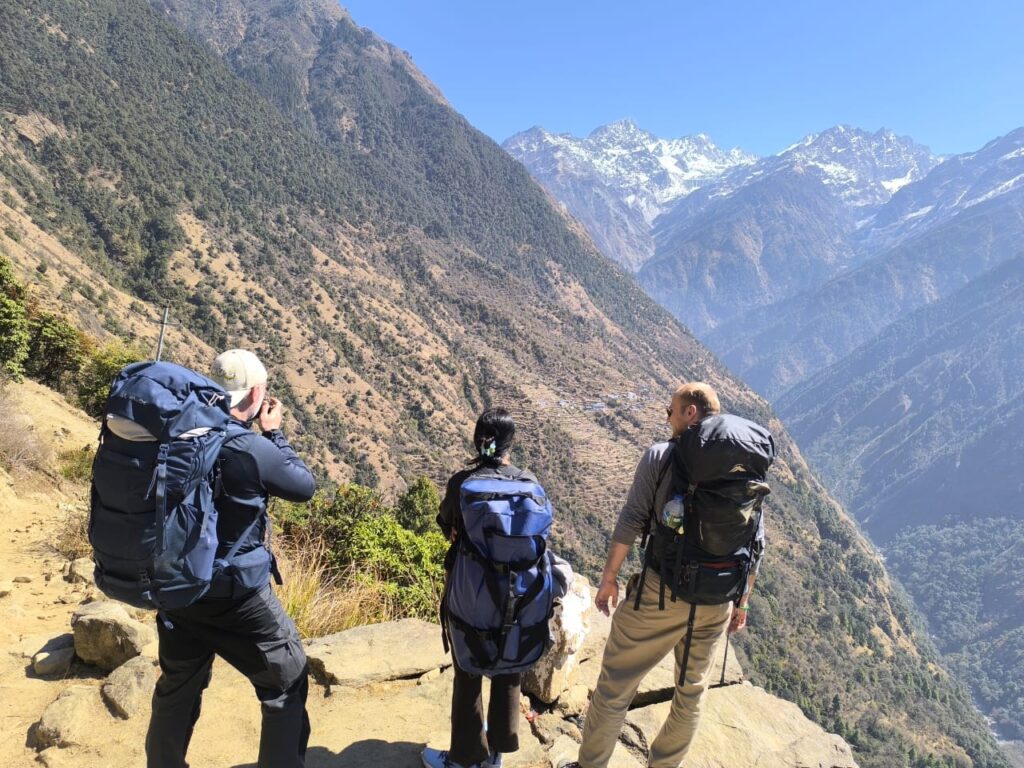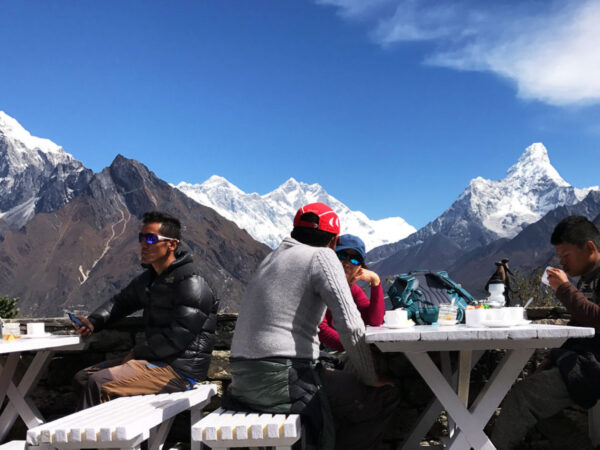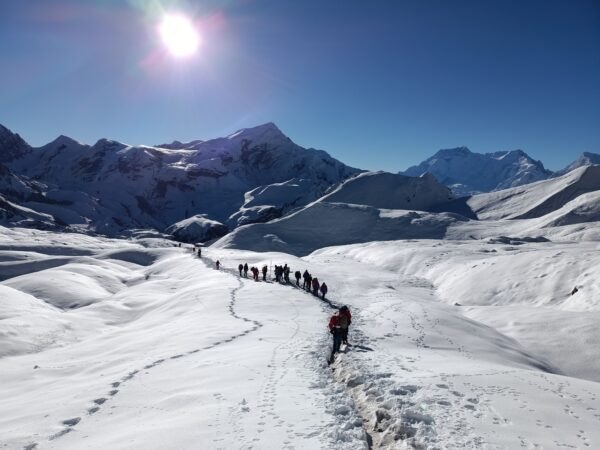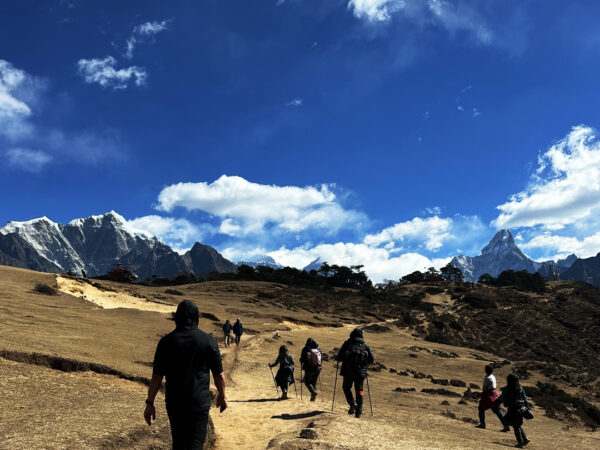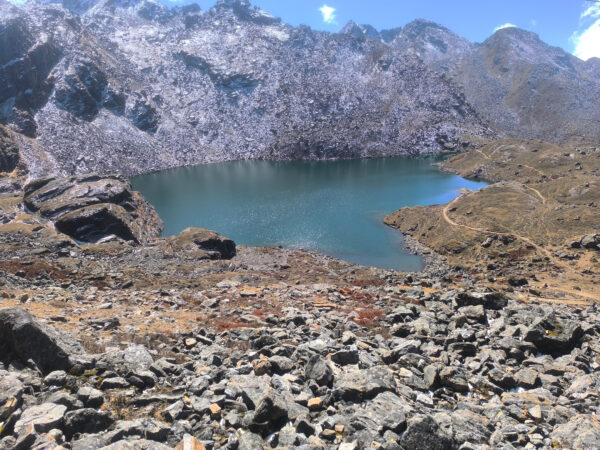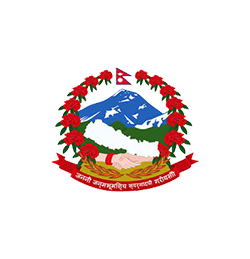Highlights
- An inspirational vista of snow-capped peaks, such as Ganesh Himal and Langtang Lirung
- Hike through verdant alpine meadows, blossoming rhododendron slopes, and lush woodlands
- Trekking in the Langtang Valley, also known as the Valley of Glaciers
- Climb the well-known viewpoint, Tsergo Ri (5,050 m), for an incredible 360° vista
- Taking the forest route and going along the riverbank
- Breathtaking sunrises and sunsets can be experienced from multiple spots along the trail
- Possibility of seeing some endangered animals, such langur monkeys and red pandas, etc.
- Immerse yourself in the distinctive customs and cordial welcome of the Tamang people
- The Distinctive Tamang and Tibetan Traditions and Culture
- The amazing and kind welcome of the locals
Overview
The Langtang Valley Trek is an adventurous journey through one of Nepal’s most scenic and culturally vibrant regions, nestled in the shadow of the majestic Himalayas. The trek starts with a picturesque drive from Kathmandu to Syabrubesi, the gateway to the Langtang region. From here, trekkers embark on a trail that winds through lush forests, terraced fields, and traditional Tamang villages, providing a glimpse into the local way of life.
As trekkers ascend higher into the Langtang Valley, they are rewarded with breathtaking views of snow-capped peaks, including Langtang Lirung (7,227 meters) and Dorje Lakpa (6,966 meters). The trail passes through Langtang National Park, which is home to diverse flora and fauna, including rare species such as the red panda and the Himalayan Thar. Along the way, trekkers may encounter yaks grazing in high-altitude pastures and colorful prayer flags fluttering in the mountain breeze.
A highlight of the Langtang Valley Trek is the visit to the remote village of Kyanjin Gompa, situated at an altitude of 3,870 meters. Here, trekkers can explore the ancient monastery, interact with local monks, and enjoy panoramic views of the surrounding Himalayas. Trekkers can also hike to the stunning Kyanjin Ri viewpoint, which offers unparalleled vistas of the Langtang Himalayas.
After immersing themselves in the natural beauty and cultural richness of the Langtang Valley, trekkers retrace their steps back to Syabrubesi, concluding their journey with a sense of fulfillment and appreciation for the wonders of the Himalayas. The Langtang Valley Trek offers a perfect blend of scenic beauty, cultural encounters, and Himalayan adventure, making it a memorable experience for trekkers of all levels.
Best time for Langtang Valley Trek
Trekking to Langtang Valley is possible year-round, but spring and autumn are the best times to embark on the Langtang Trek. During autumn, the weather is mild with clear skies most days, creating ideal hiking conditions and offering spectacular views of the Himalayas throughout the trek.
The only downside to trekking in autumn is the crowded trails, although they are less crowded than those in the Everest or Annapurna regions. In spring, the temperature is warmer, but the sky can sometimes appear hazy.
Winter brings cold, harsh weather, especially at higher altitudes. Thick snow covers the trails, making trekking difficult, particularly above 3,500 meters. However, the clear skies offer stunning views. If you plan to trek to Langtang Valley in winter, ensure you have warm clothing and a high-quality sleeping bag.
Monsoon is the least popular time for trekking in Langtang due to unpredictable weather, muddy and slippery trails, and the increased risk of leeches in the dense forests. Trekking during this season requires careful planning and packing.
Foods and Accommodation for Langtang Valley Trek Package
You should not expect the standard quality of food and accommodation on this trek. Since the region is remote and lacks roadways, accommodations are quite basic. Tea houses and guest houses, commonly run by locals, are the primary options for staying overnight. These accommodations offer simple rooms with basic amenities, and your room may or may not have an attached bathroom. Single rooms are rare, so you will likely need to share. Typically, there is a large dining hall where you can relax and chat with the locals after dinner.
Dal Bhaat will be your staple food during the trek, with three meals provided daily. As you climb higher, food options become more limited, but you will still have some variety. Breakfast choices include Tibetan bread, toast, eggs, tea or coffee, and cereals. Lunch and dinner menus are similar, featuring Dal Bhaat, pasta, noodles, soup, macaroni, pizza, potato wedges, and more.
Explore the Best Treks in the Langtang Region
The Langtang region offers various alternative and reliable treks. The Langtang Valley Trek features picturesque villages and stunning mountain views, while the Ganja La Pass Trek presents a challenging route with breathtaking panoramas. The Tamang Heritage Trail provides cultural experiences and beautiful landscapes. The Langtang Gosaikunda Trek combines the beauty of Langtang Valley with the sacred Gosaikunda Lakes, known for their stunning glacial scenery. Short hikes to Kyanjin Ri and Tserko Ri offer spectacular views, while the Yala Peak Climb combines trekking with climbing for impressive vistas.
Itinerary
Day 1: Drive from Kathmandu to Khanjim (2,280m) – 7-8 hours
Day 2: Trek from Khanjim to Rimche (2,324m) – 5-6 hours
Day 3: Trek from Rimche to Langtang Village/Mundu (3,330m) – 5-6 hours
Day 4: Trek from Langtang Village to Kyanjin Gompa (3,870m) – 4-5 hours
Day 5: Hike to Kyanjin Ri (4,773m) and return to Kyanjin Gompa – 5-6 hours
Day 6: Trek from Kyanjin Gompa to Lama Hotel (2,324m) – 5-6 hours
Day 7: Trek from Lama Hotel to Syabrubesi – 4-5 hours
Day 8: Drive back to Kathmandu – 7-8 hours
Langtang Valley Trek – 8 Days - Itinerary
Drive from Kathmandu to Khanjim (2,280m) – 7-8 hours
After an early breakfast, we drive north from Kathmandu to Syabru Besi. Portions of the road are unpaved, and its condition often varies depending on the monsoon season. Our route takes us through Trisuli Bazaar, where the Indian Technical Mission completed a dam and hydroelectric project. Finally, we drive on to Syabrubesi and trek to Khanjim.
Trek from Khanjim to Rimche (2,324m) – 5-6 hours
After breakfast, we will start our trek. The trail continues past the village and crosses a suspension bridge. We will then ascend alongside the Langtang Khola river through the forest until we reach Pairo, which takes about 3 hours. Here, we will take a lunch break. After lunch, we will continue trekking through deep forests to Bamboo, a journey of about 1.5 hours. The trail then ascends steeply through more forested areas, and we cross another suspension bridge before a final steep climb that brings us to Lama Hotel in about 2 hours.
Trek from Rimche to Langtang Village/Mundu (3,330m) – 5-6 hours
The trail continues through the forests until reaching Gumnachok, which takes about an hour and a half. From there, you hike to Godatabela, which takes approximately 2 hours. At this point, you can catch a glimpse of Langtang Lirung and take a lunch break.
After lunch, the trail passes through yak pastureland and forests, reaching Thangshyap in about 2 hours. The trail then ascends to Chyamki, a journey of about an hour and a half. You'll cross a suspension bridge and continue to Langtang village, which takes about an hour.
In Langtang village, you can enjoy a splendid view of Langtang Lirung, other peaks, and a beautiful waterfall. In the evening, you can visit an old monastery with your guide.
Trek from Langtang Village to Kyanjin Gompa (3,870m) – 4-5 hours
Today involves a brief walk from Langtang to Kyanjin Gompa. The trail winds through yak pastureland, and the journey to Kyanjin Gompa takes about three hours at a leisurely pace. Upon arrival, you'll have lunch. In the afternoon, you can explore Kyanjin Gompa and visit the Cheese Factory with your guide to sample yak cheese. Enjoy the stunning views of Langtang Lirung, Gangchempu, Nayakhang, and other peaks.
Hike to Kyanjin Ri (4,773m) and return to Kyanjin Gompa – 5-6 hours
Today, we will hike to Kyanjin Ri, which stands at 4,773 meters. This peak is lower compared to Tsergo Ri, which can be challenging for beginners. If you're seeking more adventure, consider hiking to Tsergo Ri at 4,985 meters. Both hiking destinations offer stunning mountain views.
We begin our hike in the morning after breakfast. The first part of the trail is level and takes about 30 minutes to cross a small stream. Afterward, the trail becomes steep, with panoramic views of snow-capped mountains. The ascent to the top takes about three and a half hours. From Tsergo Ri, you can enjoy superb views of Langtang Lirung, Nayakhang, Gangchembu, the Ganja-La range, Yala Peak, Langshisha Ri, and other snowy peaks.
If you plan to explore more and spend extra time at the top, it's advisable to bring a packed lunch from your lodge. After enjoying the views, the descent back to the lodge takes about two and a half hours. Another day hiking destination from Kyanjin Gompa is Langshisa Kharka.
Trek from Kyanjin Gompa to Lama Hotel (2,324m) – 5-6 hours
The trail descends through yak pasture lands for about 2 hours until reaching Langtang. From there, you continue, crossing a suspension bridge and descending to Thangshyap in about 1 hour. Continuing through forests for another hour brings you to Godatabela, where you'll break for lunch. After lunch, the trail descends further until reaching Lama Hotel.
Trek from Lama Hotel to Syabrubesi – 4-5 hours
After breakfast, we trek downhill to Syabrubensi, which takes about 5 hours. Enjoy the gentle trail through lush green vegetation. Upon reaching Syabrubesi, we stop for lunch.
Drive back to Kathmandu – 7-8 hours
After breakfast, we return to Kathmandu. Upon arrival in Kathmandu, you will be transferred to your hotel. Spend the day at leisure, indulge in some last-minute shopping, or revisit any sights you may have missed on your first day in Kathmandu.
Inclusions
What's included
- Airport transfers - pickup and drop off
- Kathmandu to Syabrubesi by bus
- Meals (Breakfast, lunch, dinner) during the trek
- An english speaking trekking guide
- A porter to carry your luggage (1 porter for every 2 trekkers)
- Fresh fruits during the trek
- TIMS (Trekkers’ Information Management System) Card and Langtang National Park Permits
- Government Taxes, local taxes (if any)
- First Aid Kits
- Sleeping bag and Down Jacket, Duffel bag, and Trekking pole
What's not included
- Nepal Travel Visa Fee
- Personal Medical and Travel insurance (Should cover helicopter evacuation)
- Guide, Porter and Driver tips
- Hotel in Kathmandu
- All other personal expense of beverages (hard and soft drinks)
- All other things not mentioned in the inclusion.
Equipment
Recommended Trekking Gears
Clothing
- Base Layers (Moisture-Wicking)
- Thermal tops and bottoms (polyester or merino wool)
- Lightweight long-sleeve shirts
- Insulating Layers
- Fleece jacket or pullover
- Down jacket (for high-altitude treks)
- Warm sweaters
- Outer Layers (Shells)
- Waterproof and windproof jacket (Gore-Tex or similar)
- Waterproof pants
- Trekking Pants
- Quick-dry pants
- Convertible hiking pants (zip-off into shorts)
- Trekking Shirts
- Lightweight and breathable T-shirts
- Long-sleeve shirts with UV protection
- Headwear
- Wide-brim hat or cap for sun protection
- Warm beanie for cold temperatures
- Buff or scarf for dust and wind
- Gloves
- Lightweight trekking gloves
- Insulated gloves for higher altitudes
- Socks
- Moisture-wicking trekking socks
- Thermal socks for colder regions
- Footwear
- Sturdy and waterproof trekking boots (well broken-in)
- Comfortable sandals or camp shoes (for evenings/rest days)
- Gaiters (optional, for snow or muddy trails)
Backpacks & Bags
- Backpack
- 40-50L capacity for multi-day treks
- Comfortable straps and rain cover
- Daypack
- 20-30L for short treks or carrying essentials during the day
- Duffel Bag
- Used if porters are carrying your gear (for organized treks)
- Dry Bags
- To keep electronics and clothes dry in wet conditions
Sleeping Gear
- Sleeping Bag
- 4-season sleeping bag (rated for -10°C to -20°C for high-altitude treks)
- Sleeping bag liner (optional, for extra warmth and hygiene)
- Sleeping Pad (if camping)
- Lightweight and inflatable or foam pads for comfort
Trekking Accessories
- Trekking Poles
- Adjustable and lightweight poles (essential for steep ascents/descents)
- Water Bottle/Hydration System
- Insulated bottle (to prevent freezing at high altitudes)
- CamelBak or similar hydration reservoir
- Water Purification
- Water filters, purification tablets, or UV sterilizers
- Sunglasses
- UV protection (Category 3 or 4 for snowy conditions)
- Headlamp
- With spare batteries (essential for early morning or late-night treks)
- Multi-tool or Knife
- For various small tasks
- First Aid Kit
- Bandages, blister patches, antiseptic wipes, painkillers, Diamox (for altitude sickness), etc.
- Lip Balm
- SPF-protected to prevent chapping
- Sunscreen
- High SPF for UV protection at higher altitudes
- Personal Toiletries
- Biodegradable soap, toothpaste, toothbrush, quick-dry towel, wet wipes, and toilet paper
Optional but Useful Items
- Camera
- To capture the stunning scenery (extra batteries and memory cards are a must)
- Snacks
- Energy bars, trail mix, or chocolate for quick energy boosts
- Power Bank/Solar Charger
- For charging devices in remote areas
- Books or E-Readers
- For downtime during rest days
- Earplugs
- To block out noise in lodges or camps
- Notebook/Journal
- To record your trek experience
Clothing Packing Tips
- Layering is key: It helps regulate your body temperature and adapt to changing weather.
- Avoid cotton: It retains moisture and dries slowly, which can lead to discomfort or hypothermia.
- Pack light: Only carry what is absolutely necessary to avoid unnecessary weight.
Gear Rentals in Nepal
If you're worried about carrying too much gear, trekking hubs like Kathmandu and Pokhara offer trekking equipment rentals and sales. You can find items like sleeping bags, down jackets, and trekking poles at reasonable prices. However, ensure you check the quality before renting.

